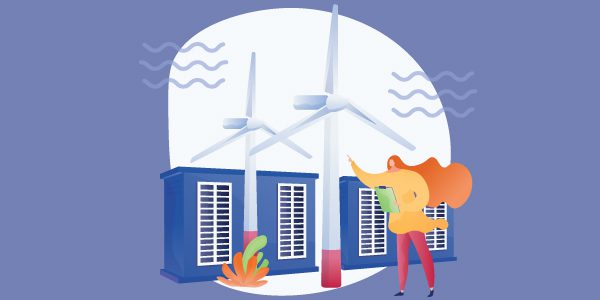Did you know that the wind industry in Africa is growing like crazy?
That’s right! More and more countries across the continent are realising the benefits of wind energy and investing in it big time. Besides being an economically sound investment for governments, wind energy projects can also help bring electricity to rural areas that aren’t connected to the grid, providing a sustainable alternative to expensive and polluting diesel generators.
In 2020, Africa had a total installed wind capacity of 6.5 gigawatts (GW), which is a massive increase from just 1.5 GW in 2010. While this is still a small percentage of the continent’s total electricity generation, the wind energy market is expected to grow at a Compound Annual Growth Rate of 3% between 2023 and 2028.
Africa is currently only tapping into 0.01% of its extraordinary wind potential. According to the International Finance Corporation, the continent has almost 180,000 terawatt hours (TWh) of wind potential. This would be enough to power the electricity demands of Africa 250 times over. So, which countries are leading the way in wind energy? South Africa is currently the biggest market for wind energy in Africa, with over 2 GW of installed capacity. But Egypt, Morocco, Kenya, and Ethiopia are all emerging as important wind energy markets too.
South Africa
Wind potential is high in South Africa at 6,7000 GW. The government has leaned into its potential through its Integrated Resource Plan (IRP), which could result in 14.4 GW of wind energy being installed between 2022 and 2030. Most of the projects thus far have been built in the coastal (and high-wind yielding) areas of the Eastern and Western Cape.
Egypt
There are a few large wind projects that are in development or are going to be in the near future. One is the Gulf of Suez wind farm in Ras Ghareb, which is expected to be built in two stages, and will be connected to the grid in the latter half of 2025. This project will provide electricity for over 800,000 homes.
On an even larger scale, an eye-watering $11 billion 10 GW plant is currently underway and is expected to be operational in 2030. This project will not only supply Egypt but will be exported to Saudi Arabia and potentially even Europe.
Morocco
Morocco is home to the third-largest onshore wind fleet in Africa. Just like many countries in Africa, Morocco has significant wind power potential. So much so, that with wind energy, it would be able to cover its electricity needs 17 times over. With an overreliance on imported electricity (90% coming from overseas), Morocco is speeding up its adoption, with 1.8 GW of wind energy expected to be added by 2026.
For offshore wind, Morocco ranks first on the continent, followed by South Africa. While wind speeds vary considerably across the Moroccan coast, the Southern Atlantic area averages above 10 m/s. However, with depths ranging from 60 to 500 metres in that area, it will require floating offshore wind turbines, which have significantly higher capital costs.
Barriers
While wind energy is growing across the continent, there are a number of barriers that are slowing its adoption. Although economic crimes and political instability play a significant role in deterring projects and investment, the biggest challenges for wind energy in particular are a lack of grid infrastructure, project financing, and confusing processes and policies.
Barrier One: Infrastructure
One of the biggest challenges is the lack of grid infrastructure in many parts of Africa, which can make it difficult to connect wind energy projects to the grid. This is both for onshore and offshore farms. There’s also the need to reinforce the grid, which has been recommended to the Moroccan government for the regions of Rabat and Casablanca, which have high energy demands. Governments should start building the grid infrastructure as soon as possible to ensure that projects aren’t delayed or, worse, stopped before they can even start. A big example is the Lake Turkana project in Kenya, which had turbines built and ready, but the power could not be used for 15 months, as the farm was not connected to the grid.
Barrier Two: Financing
Money is a huge hindrance as well. Having domestic and foreign investment is key to getting projects off the ground. In sub-Saharan Africa, the International Finance Corporation (World Bank) has arranged more than $3 billion worth of investment into infrastructure establishment across the region. Governments should work towards setting up bodies that are focused on increasing investment by having clear pathways for international groups to invest in their country.
Currently, only around 25 countries across Africa already have these in place. One is the Renewable Energy Independent Power Producers Procurement Programme in South Africa. This government initiative seeks to increase private investment in renewable energy through competitive tender processes.
Barrier Three: Policy Frameworks
Convoluted policies and procedures are another massive obstacle to renewable energy projects. To increase investment (both foreign and domestic) and get projects up and running in the first place, it requires governments to have a clear green energy strategy and a streamlined process to implement projects. Just like the obstacle of financing, setting up bodies or organisations that can help facilitate projects and demystify the process, is a way to mitigate this hurdle. Complex frameworks and policies will only deter projects and investment.
Despite the challenges, the wind industry in Africa is on the rise and has the potential to play a huge role in the continent’s transition to a more sustainable energy system. Governments, international organisations, and private sector investors are all working together to support the growth of the wind industry and overcome the obstacles standing in the way. The wind potential in Africa is enormous, so next time you feel a cool breeze on your face, just think – that wind could be harnessed and turned into clean, sustainable energy that powers homes and businesses across Africa.












